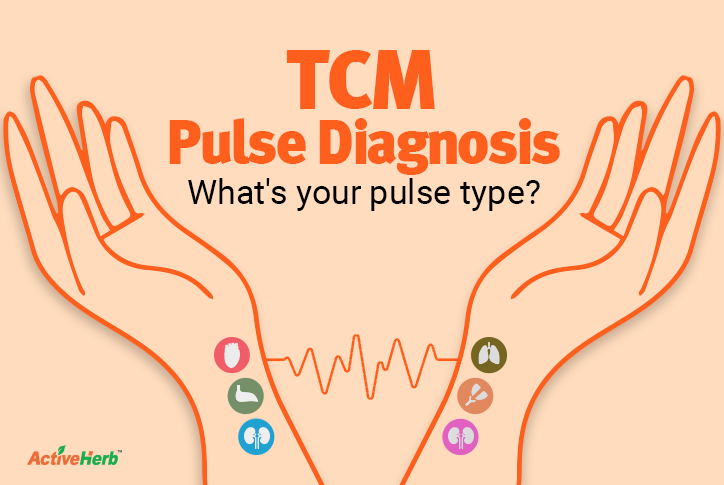TCM Pulse Diagnosis: What’s Your Pulse Type?

Pulse diagnosis is a pillar of both Western medicine and traditional Chinese medicine (TCM). But unlike western medicine, which only assesses pulse rate and blood pressure, TCM practitioners have approximately 30 different pulse types to work with.
You’re probably not interested in learning about all 30—otherwise you would have probably become an acupuncturist. But for a general overview, let’s learn what your pulse type may say about your health…
Pulse Diagnosis in TCM
Along with looking, asking and listening, touch is one of the four pillars of diagnostics in TCM. Tongue analysis (looking) and pulse type (touch) are perhaps the two most common diagnostic tools in TCM.
When conducting a pulse analysis, the TCM practitioner will palpate the wrist to find the pulse. The practitioner places three fingers over 3 points on the thumb-side of both the left and right wrist, just below the carpal tunnel. These 3 points correspond to TCM meridians. On the left wrist, the 3 points mirror the Heart, Liver and Kidney; the right wrist assesses the general state of the Lung, Spleen and Kidney.
There is not a clear consensus on exactly how many pulse patterns exist in TCM diagnostics. Some ancient Chinese texts say there are 30, others claim there are more than that. And some texts argue that the true number is in the low 20’s. So let’s split the difference and call it 25, and here are some of them by name:
- Low pulse
- Moderate pulse
- Deep pulse
- String pulse
- Surging
- Weak pulse
- Hollow pulse
- Faint pulse
- Long pulse
- Scattered pulse
- Irregular pulse
- Swift pulse
Why so many different pulse types?
Well, the reason why is that as you can see, each one describes the quality of the pulse. And based on this information, the practitioner can ascertain which organ systems are imbalanced, how deeply in the body the imbalance has penetrated and what the proper course of action is (for example, which TCM formulas will help restore Yin/Yang harmony).
Examples of TCM Pulse Qualities
Now let’s take a look at some of the TCM pulse types listed above. What on Earth is a slippery pulse, you may be wondering? In TCM medical texts, pulse types are often associated with a metaphor. In this instance, a slippery pulse is like beads or pearls rolling.
Another curious example is string pulse. In TCM, this pulse type is compared to the pressing down on a stringed musical instrument like a violin.
One more type of qualitative pulse type is a “surging” one. Picture an ocean swell with smaller waves quickly getting more powerful and bigger and then crashing on shore.
Some pulse types are more quantitative descriptors rather than qualitative. For example, here’s an easy one: a rapid pulse describes a very fast heart beat.
Many pulse types overlap with each other. But a TCM practitioner isn’t trying to differentiate necessarily between the 25 or so pulse types. They are also assessing a patient’s rate of breathing, and if there’s an accelerated pattern of breathing matched by a rapid pulse, it’s an indication there is excess heat in the body.
On the flip side, a slow, lethargic pulse represents a deficiency caused by a cold condition such as Cold-Dampness.
TCM Pulse Characteristics
Have you ever thought you were a zombie for a second because you couldn’t find your pulse? Well, it may just be that you have a deep pulse. In TCM pulse diagnosis, depth matters. And let’s suppose you’re feeling very imbalanced and have a deep pulse. This means you or the practitioner has to palpate much firmer to locate the pulse… This reveals the imbalance is deep within the body—possibly even within the physical organs.
And if your pulse is easily detected, then you have what’s called a “floating” pulse. In this instance, your pulse is literally skin deep and whatever external evil has infiltrated your body has, to this point, not penetrated too far.
A TCM practitioner will also assess your Qi (energy) level by taking your pulse. A weak pulse indicates a Qi deficiency. Even if your pulse is easily detected, it doesn’t necessarily mean you have abundant Qi. On the contrary, your pulse may be “soggy” or “thin” which indicates Qi and/or Blood depletion as well as excess dampness.
The Ideal Pulse Type in TCM
So what’s the best pulse type to have according to TCM?
If having an abundance of Qi is your desire, then you want a full pulse. But you don’t want a wiry pulse, which is one of the most common types of pulse qualities. A wiry pulse indicates an abundance of Qi albeit way too much of it. People who have a lot of stress in their life—and don’t do anything to manage it—may present with a wiry pulse.
ActiveHerb.com does not offer individual pulse diagnosis, but we do offer herbal solutions to your health concerns that are right for you.






